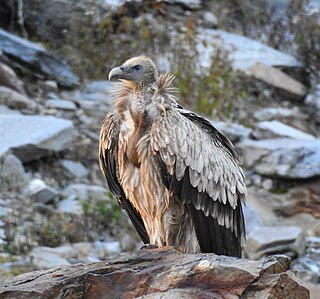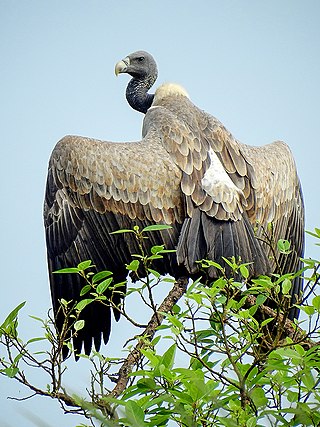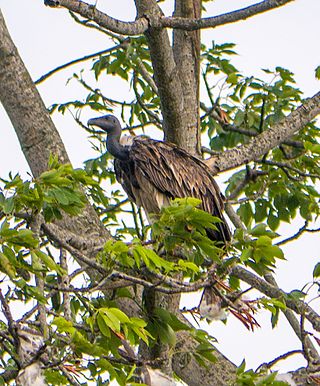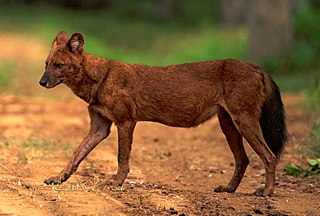
A vulture is a bird of prey that scavenges on carrion. There are 23 extant species of vulture. Old World vultures include 16 living species native to Europe, Africa, and Asia; New World vultures are restricted to North and South America and consist of seven identified species, all belonging to the Cathartidae family. A particular characteristic of many vultures is a bald, unfeathered head. This bare skin is thought to keep the head clean when feeding, and also plays an important role in thermoregulation.

Old World vultures are vultures that are found in the Old World, i.e. the continents of Europe, Asia and Africa, and which belong to the family Accipitridae, which also includes eagles, buzzards, kites, and hawks.

The Himalayan vulture or Himalayan griffon vulture is an Old World vulture native to the Himalayas and foothills in North and Northeastern India, as well as the adjacent Tibetan Plateau. After the cinereous vulture, it is the second-largest Old World vulture species, and among the world's largest true raptors. It is listed as Near Threatened on the IUCN Red List. It is not to be confused with the Eurasian griffon vulture, which is a visually similar, sympatric species.

The white-rumped vulture is an Old World vulture native to South and Southeast Asia. It has been listed as Critically Endangered on the IUCN Red List since 2000, as the population severely declined. White-rumped vultures die of kidney failure caused by diclofenac poisoning. In the 1980s, the global population was estimated at several million individuals, and it was thought to be "the most abundant large bird of prey in the world". As of 2021, the global population was estimated at less than 6,000 mature individuals.

The Indian vulture or long-billed vulture is a bird of prey native to the Indian subcontinent. It is an Old World vulture belonging to the family of Accipitridae. It is a medium-sized vulture with a small, semi-bald head with little feathers, long beak, and wide dark colored wings. It breeds mainly on small cliffs and hilly crags in central India and south India.

The white-backed vulture is an Old World vulture in the family Accipitridae, which also includes eagles, kites, buzzards and hawks. It is the most common vulture species in the continent of Africa.

Diclofenac, sold under the brand name Voltaren, among others, is a nonsteroidal anti-inflammatory drug (NSAID) used to treat pain and inflammatory diseases such as gout. It can be taken orally, inserted rectally as a suppository, injected intramuscularly (IM), injected intravenously (IV), or applied to the skin topically. Improvements in pain last up to eight hours. It is also available in combination with misoprostol in an effort to decrease stomach problems.

Pamela Cecile Rasmussen is an American ornithologist and expert on Asian birds. She was formerly a research associate at the Smithsonian Institution in Washington, D.C., and is based at the Michigan State University. She is associated with other major centers of research in the United States and the United Kingdom.

The slender-billed vulture is an Old World vulture species native to sub-Himalayan regions and Southeast Asia. It is Critically Endangered since 2002 as the population on the Indian subcontinent has declined rapidly. As of 2021, fewer than 870 mature individuals are thought to remain.

Captive breeding, also known as captive propagation, is the process of keeping plants or animals in controlled environments, such as wildlife reserves, zoos, botanic gardens, and other conservation facilities. It is sometimes employed to help species that are being threatened by the effects of human activities such as climate change, habitat loss, fragmentation, overhunting or fishing, pollution, predation, disease, and parasitism.

The red-headed vulture, also known as the Asian king vulture, Indian black vulture or Pondicherry vulture, is an Old World vulture mainly found in the Indian subcontinent, with small disjunct populations in some parts of Southeast Asia.
The Amphibian Ark is an organization that focuses on the conservation of amphibian populations by planning and implementing ex situ programs in zoos and wildlife organizations around the world.
The Peregrine Fund is a non-profit organization founded in 1970 that conserves threatened and endangered birds of prey worldwide. The successful recovery of the peregrine falcon in the United States, which was removed from the U.S. Endangered Species List in 1999, enabled the organization to expand its mission to include other endangered raptors around the world. The Peregrine Fund is headquartered at its World Center for Birds of Prey in Boise, Idaho, on a 580-acre (2.3 km2) campus with breeding and research facilities, an administrative office, interpretive center, research library, and archives.
Birds International Incorporated or BII is a company working in the field of aviculture established in 1975 by Antonio de Dios. It is located in Quezon City near Manila, the capital of the Philippines.

An endangered species is a species that is very likely to become extinct in the near future, either worldwide or in a particular political jurisdiction. Endangered species may be at risk due to factors such as habitat loss, poaching, invasive species, and climate change. The International Union for Conservation of Nature (IUCN) Red List lists the global conservation status of many species, and various other agencies assess the status of species within particular areas. Many nations have laws that protect conservation-reliant species which, for example, forbid hunting, restrict land development, or create protected areas. Some endangered species are the target of extensive conservation efforts such as captive breeding and habitat restoration.

Nine species of vulture can be found living in India, but most are now in danger of extinction after a rapid and major population collapse in recent decades. In the early 1980s, three species of Gyps vultures had a combined estimated population of 40 million in South Asia, while in 2017 the total population numbered only 19,000.

The Jatayu and Sparrow Conservation Breeding Centre (JCBC), is the world's largest facility for the breeding and conservation of Indian vultures and the house sparrow. It is located within the Bir Shikargah Wildlife Sanctuary in the town of Pinjore in the State of Haryana, India. It is run by the Haryana Forests Department and Bombay Natural History Society with the help of British nature conservation charity Royal Society for the Protection of Birds. It is 8 kilometres (5.0 mi) from Pinjore and covers 5 acres (2.0 ha).
A vulture restaurant is a site where carrion, decaying flesh from dead animals, is deposited in order to be consumed by vultures, and is sometimes referred to more generally as supplemental feeding or provisioning. These stations can also be referred to as vulture feeding sites, vulture feeding stations, and vulture safe zones. This supplemental feeding practice is used to provide vultures with reliable, non-contaminated food sources or to aid in monitoring schemes. Vulture restaurants have been instituted as a method of vulture conservation in Europe and Africa since the 1960's and 70's, when vulture populations began to decline. This strategy is used because often population declines are attributed to low food availability, food contamination or insufficient nutritional quality, or feeding from human areas leading to conflict. Notably, large vulture population declines in South Asia, referred to as the Asian or Indian vulture crisis, and Africa, referred to as the African vulture crisis, have brought renewed attention to the uses and impacts of vulture restaurants. Vulture restaurants are used in Asia, Africa, Europe, and North America for various conservation and management plans. They can help combat food-derived threats to vultures, such as diclofenac or lead contamination or conflict with ranchers and poachers. The first vulture restaurant was built in South Africa in 1966. Vulture restaurants operate in a number of countries, including Nepal, India, Cambodia, South Africa, Eswatini, and Spain.
Debbie Pain is a conservation biologist and ecotoxicologist working on endangered birds around the world. Since 1988 she has led projects into reversing the decline in several species through research, practical and policy measures at the Royal Society for the Protection of Birds and Wildlife and Wetlands Trust.
Jatayu vulture restaurant is the first community managed vulture restaurant in the world. It is located in Pithauli of Nawalparasi district in Nepal in the buffer zone of Chitwan National Park. It was established in 2006. It provides safe food to vulture. The facility attracts tourists and conservationists from around the world. The vultures fed at this place has been tracked to have reached up to Pakistan.













